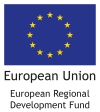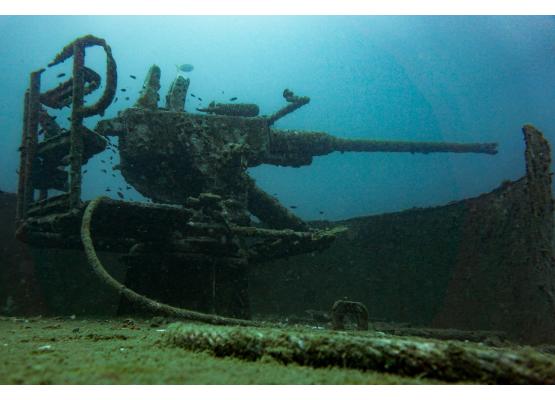In English
How would you introduce yourself?
My name is Marii Asmer, I led the BALTACAR project, which had six partners in addition to the National Heritage Board of Estonia. Together with my colleague Maili Roio, I was involved in the application and project preparation phase. After a year or leading the project, I went on parental leave, after which I returned part-time and worked on the project until its end.
What was project BALTACAR about?
Aim of the project was to show the uniqueness of our underwater cultural heritage, which can also be visited on-site, and that it is possible to show its attractiveness to guests and divers. Here in the Baltic Sea, we actually have a very cool underwater cultural heritage that is worth visiting. It is not always the case that the water is dark and cold and the visibility poor. Diving here is certainly a bigger challenge than in warm and transparent waters. At the same time, we have received feedback, and we see for ourselves, that more and more divers are visiting our wrecks every year. We have realized that diving here does offer something more - a challenge -, and the experience that visitors get is also great.
What have been the first impressions after project has ended?
All in all, we are satisfied. There were challenges, but they were solved and good relations were maintained with everyone. We found solutions for all planned activities. There was a setback with the website, but in other respects, everything that had been promised, was done, even more so. The Swedes even set up new companies to further develop the results of the project, so they are particularly pleased.
How was your partnership formed?
Our wish was to definitely involve partners from Estonia, Sweden and Finland, in fact also from Åland, but for some reason we have never succeeded with the latter. However, the Åland Heritage Board has now been an associate partner. We had already cooperated with partners from Sweden during the previous programming period.
Among the institutions representing public interests, we contacted the Finnish Heritage Board and Swedish Maritime Museum. The partners, in turn, helped to find other partners, both from the private sector, such as diving service providers, and, in Sweden, from the local government. On the Estonian side, we also involved a diving company with which the National Heritage Board had previously had positive contacts. In order to achieve a holistic approach, we wanted different interests to be represented, both from the public sector, which is responsible for preserving cultural heritage, and from the private sector, which has an interest in bringing visitors. In Estonia, a first-time partner was also Western Estonia tourism, whose contribution turned out to be larger than planned. The partnership generally worked very well.
The implementation of the project generally proceeded as expected. Cooperation with the programme secretariat went smoothly, the flexibility was noticeable, more than in the previous period.
What is the most important result of project BALTACAR?
In cooperation with the three countries, we wanted to show the joint unique heritage of the Baltic Sea, and that it is worth visiting and coming to the region. In addition to the underwater heritage, it is also important to introduce the area, for example, the partners also developed on-land excursions. It is a niche product, but there has been a lot of interest in it.
Whereas banning or restricting diving into wrecks was a fairly common practice in the past, this is not the case today, and thanks to the documentation work and 3D models resulting from the Baltacar project, there is now a thorough overview of shipwrecks. The data collected is indispensable for the preservers of cultural heritage. Among other things, it provides an overview of how visits have affected the wrecks. In addition, we can now introduce the underwater heritage to those who never go scuba diving.
Depending on the level of equipment on the dive, both finding the wreck and dropping the anchor can take a long time or even fail, or in the worst case, destroy the wreck. We installed anchor buoys to the bottom of the Baltic Sea to help locate wrecks at sea more easily and allow divers to moor their boats without having to drop their anchors on the seabed and risk damaging the wrecks. Thanks to 3D models, diving is also made safer by providing an opportunity to get to know the wrecks before going into the water, also doing preliminary work regarding where different parts of wrecks are located.
As divers begin to descend along the buoys, they are greeted by an information board with a map marking their location with red dots, giving an idea of the exact location of the underwater museum visitor, as if in a real museum. The chain of the anchor buoy leading to the wreck is so close that the wreck is immediately visible when going under water, which ensures that the diver is in the right place and does not have to spend valuable time in the water searching for the wreck.
The information boards in Estonian waters are somewhat simpler, as the so-called bottom time is shorter compared to Finnish waters due to greater depths, which means that there would be no time to read longer stories. The depths of Finnish waters are shallower, therefore pyramid-shaped concrete constructions have been installed next to the wrecks, providing visitors with stories that give an idea of the history of the wreck and other tips and tricks.
What are the success factors of cross-border projects according to you?
When you implement a project for the first time, you never know how will everything go with your partners – surprises may occur. We have developed a partner network to turn to. Having previous experience of cooperation will make future partnerships much easier.
Communication with partners (especially as a lead partner) is very important, especially face-to-face meetings, for example. If the project and the partnership are already working, most things can nowadays be done via e-mail, it is not difficult to “catch” people. At the same time, we immediately added a budget line to the application such as monitoring and guidance meetings - as a lead partner, in addition to joint meetings, we planned at least one visit to partners in Sweden and Finland each year. Various topics constantly come up, so I recommend individual meetings with partners to address specific topics and resolve individual issues more easily.
Eesti keeles
Kuidas ennast tutvustaksid?
Olen Marii Asmer, juhtisin projekti BALTACAR, millel lisaks Muinsuskaitseametile kui juhtpartnerile oli veel kuus partnerit. Olin koos kolleegi Maili Roioga ettevalmistusfaasi juures ning jõudsin projektiga töötada ligikaudu aasta. Seejärel jäin lapsega pooleks aastaks koju, pärast mida naasesin osalise koormuse tööpostile ja tegelesin projektiga lõpuni välja.
Kuidas projekti BALTACAR lühidalt kokku võtaksid?
Projekti eesmärgiks oli näidata meie veealuse kultuuripärandi unikaalsust, mida on võimalik külastada ka kohapeal, ning et on täiesti võimalik seda näidata ka atraktiivsena külalistele ja sukeldujatele. Meil siin Läänemeres on tegelikult väga kift veealune kultuuripärand, mida tasub külastada. Ei ole nii, et alati on vesi pime ja külm ning nähtavus kehv. Kindlasti on siin sukeldumine soojade ja läbipaistvate vetega võrreldes suurem väljakutse. Samas oleme saanud tagasisidet, ja näeme ise, et iga aastaga on aina rohkem sukeldujaid meie vrakke külastamas. Oleme mõistnud, et siin sukeldumine pakubki midagi enamat – väljakutset, samuti on elamus, mille külastajad saavad, vägev.
Millised on esmamuljed pärast projekti lõppemist?
Oleme kokkuvõttes rahul. Oli väljakutseid, kuid need said lahendatud ning head suhted säilisid kõigiga. Leidsime lahendused kõikide planeeritud tegevuste teostamiseks. Veebilehega tekkis küll tagasilöök, kuid muus osas sai kõik lubatu tehtud, enamgi veel. Rootslastel tekkisid uued ettevõtted, mis tegelevad projekti tulemuste edasiarendamisega, seega on nemad eriti rahul.
Kuidas kujunes partnerlus?
Meie soov oli kindlasti kaasata partnereid Eestist, Rootsist ja Soomest, tegelikult ka Ahvenamaalt, kuid millegipärast ei ole see meil kunagi õnnestunud. Siiski on Ahvenamaa Muinsuskaitseamet olnud nüüd assotsieerunud partner. Rootsi päritolu partneritega tegime koostööd juba eelmisel programmiperioodil.
Avalikke huve esindavate asutuste seast võtsime ühendust Soome Muinsuskaitseametiga, Rootsis on varasemalt olnud partneriks Meremuuseum. Partnerid omakorda aitasid leida teisi partnereid – nii erasektorist, näiteks sukeldumistteenuse pakkujaid, kui Rootsi puhul ka näiteks kohalikust omavalitsusest. Eesti poolt kaasasime samuti sukeldumisettevõtte, kellega Muinsuskaitseametil oli varasemalt olnud positiivseid kokkupuuteid. Tervikliku lähenemise saavutamiseks soovisime, et esindatud oleksid erinevad huvid – nii osapooled avalikust sektorist, kes vastutavad kultuuripärandi säilimise eest, kui ka osalised erasektorist, kelle huvi ongi külastajaid tuua. Eestis oli esmakordseks partneriks ka Lääne-Eesti turism, kelle panus osutus suuremaks kui eelarveliselt oli plaanitud. Partnerlus toimis üldiselt väga toredasti.
Projekti läbiviimine läks üldiselt ootuspäraselt. Koostöö programmi sekretariaadiga sujus, paindlikkus oli tuntav, suurem kui eelmisel perioodil.
Mis on projekti olulisimad tulemused?
Tahtsime terviklikult, kolme riigi koostöös, näidata ühist unikaalset Läänemere pärandit, ja et seda tasub külastada ning tulla me piirkonda. Lisaks veealusele pärandile on oluline ka piirkonna tutvustamine, näiteks töötasid partnerid välja ka maapealseid ekskursioone. Tegemist on küll nišitootega, samas on huvi selle vastu osutunud suureks.
Kui vrakkidele sukeldumise keelamine või piiramine oli varem üsna levinud praktika, siis täna see nii ei ole, ning tänu projekti Baltacar tulemusena sündinud dokumenteerimistööle ja 3D-mudelitele põhjalik ülevaade laevavrakkidest. Kultuuripärandi kaitsjatele-säilitajatele on kogutud andmed asendamatud, muuhulgas annavad need ülevaate sellest, kuidas on külastamine vrakkidele mõjunud. Lisaks saame veealust pärandit tutvustada neile, kes ei lähegi kunagi vee alla sukelduma.
Sõltuvalt sukeldumisaluse varustuse astmest võib nii vraki ülesleidmine kui ankru heitmine võtta pikka aega või koguni ebaõnnestuda, halvemal juhul ka vrakki lõhkuda. Paigaldasime Läänemere põhjas asuvatele ankrupoid, mis aitavad vraki merel kergemini üles leida ning lasevad sukeldujatel oma paadi kinnitada, ilma et nad peaks oma ankrut merepõhja viskama ja riskima vraki kahjustamisega. Samuti teeb sukeldumise turvalisemaks võimalus tänu 3D-mudelitele juba enne vette minekut vrakkidega tutvuda ning teha ära eeltöö selles osas, kus miski asub.
Kui sukeldujad hakkavad mööda poid minema alla, tervitab neid infotahvel kaardiga, mis tähistab punaste täppidega nende asukoha, andes aimduse allveemuuseumi külastaja täpsest paiknemisest, justnagu päris muuseumis. Ankurdamispoi kett, mis viib vrakini, on sellele nii lähedal, et vrakk on vee alla jõudes kohe nähtav, mis kindlustab selle, et sukelduja on õiges kohas ega pea vraki otsimisele väärtuslikku vees oleku aega kulutama.
Eesti vetes asuvad infotahvlid on mõnevõrra lihtsustatumad, kuna nn põhjaaeg on Soome vetega võrreldes suuremate sügavuste tõttu lühem, mistõttu ei jätkuks pikema jutu lugemiseks aega. Soome vete sügavused on madalamad, tänu millele on seal asuvate vrakkide juurde paigaldatud püramiidikujulised betoonkamakad, millel olev tekst annab aimduse vraki ajaloo kohta ja jagab muid nõuandeid ning nippe.
Kuidas saada toimima piiriülene koostöö?
Esimest korda projekti läbi viies ei tea kunagi, kuidas partneritega läheb – võib esineda üllatusi. Meil on välja kujunenud nn partneritepagas, võrgustik, kelle poole pöörduda. Kui varasem koostöökogemus on olemas, teeb see edasise partnerluse oluliselt lihtsamaks.
Väga oluline on (eelkõige juhtparneriks olles) partneritega suhtlemine, eriti näiteks näost näkku kohtumised. Kui projekt ja partnerlus juba töötavad, saab tänapäeval ka meili teel enamus asju ajatud, inimeste tabamine ei ole keeruline. Samas kirjutasime projekti sisse kohe sellise rea nagu monitoring and guidance meetings – juhtpartnerina planeerisime lisaks ühiskoosolekutele igasse aastasse vähemalt ühe külastuse partnerite juurde nii Rootsi kui Soome. Seinast seina teemasid koguneb võrdlemisi palju, seega soovitan konkreetsete teemade käsitlemiseks ning üksikküsimuste lihtsamaks lahendamiseks individuaalseid kohtumisi partneritega.



